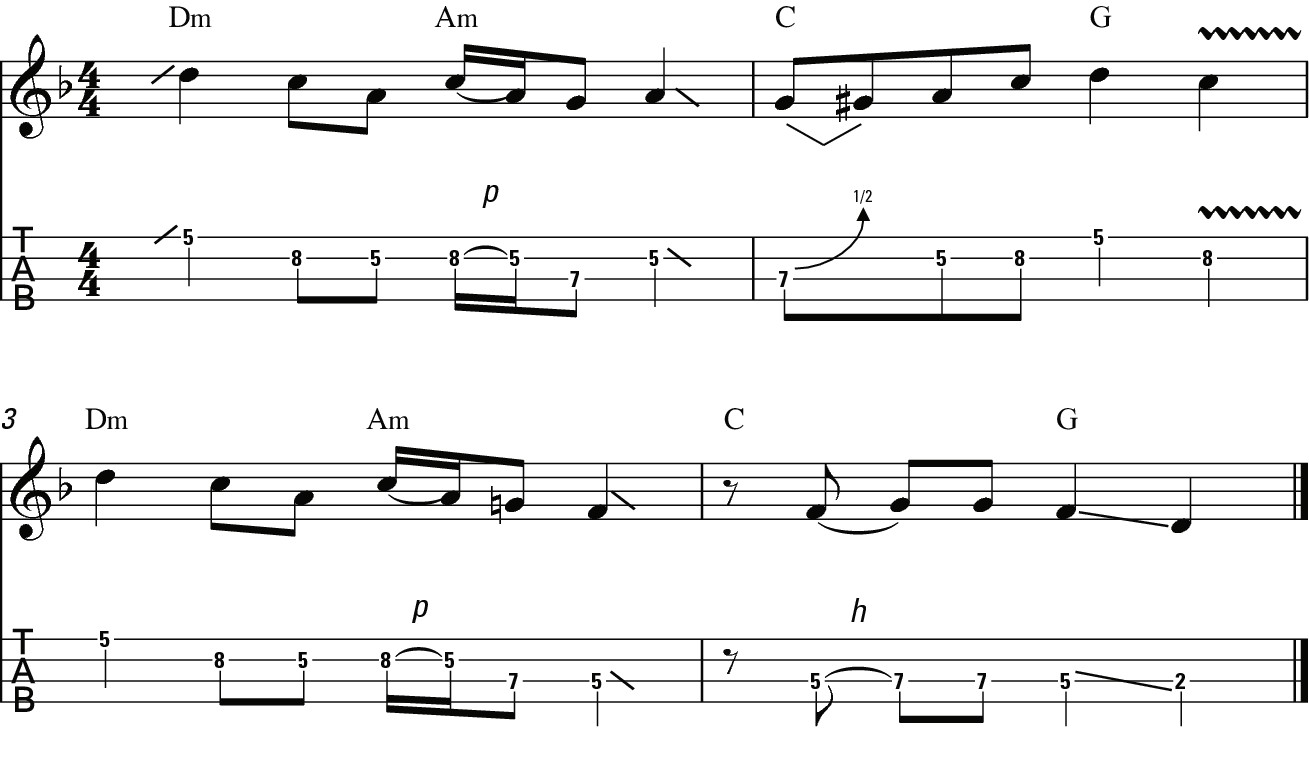Ukulele For Dummies (44 page)
Read Ukulele For Dummies Online
Authors: Alistair Wood

 When you're practising bends, try playing the note you're aiming for before attempting your bend. Doing so gives you a better idea of what you're aiming for. For example, in Figure 10-14 (Track 42) you play a note at the eighth fret and then a half-step bend at the seventh fret. When you bend at the seventh fret, it should sound the same as the eighth fret unbent.
When you're practising bends, try playing the note you're aiming for before attempting your bend. Doing so gives you a better idea of what you're aiming for. For example, in Figure 10-14 (Track 42) you play a note at the eighth fret and then a half-step bend at the seventh fret. When you bend at the seventh fret, it should sound the same as the eighth fret unbent.
Figure 10-14:
Bend practice in tab.

Producing vibrato
Vibrato
is a warble added to the end of a note and is very reminiscent of vocals. In tab, vibrato is indicated with a wavy line above the tab (shown in Figure 10-15), but you should feel free to add vibrato wherever you think it sounds good. Vibrato is not always indicated because it is such an integral part of each individual player's own sound.
Here are two ways to create vibrato:
 Bending:
Bending:
Bend the string slightly and release it. Repeat it, making sure that the note keeps ringing all the time.
 Sliding:
Sliding:
Fret the note and slide your finger back and forth within the fret. This effect is much more subtle and works better on the uke than bending.
 Vibrato is usually used on longer notes at the end of phrases. As well as adding expression to the note, it helps seek out a little extra sustain (before the note dies out).
Vibrato is usually used on longer notes at the end of phrases. As well as adding expression to the note, it helps seek out a little extra sustain (before the note dies out).
Figure 10-15:
Vibrato in tab.

Putting everything together
 When you're on top of all the techniques that I describe in this section (hammer-ons, pull-offs, slides, bends and vibrato), you can bring them together to create a solo like the one in Figure 10-16 (Track 43). In this example, all notes are picked with the thumb.
When you're on top of all the techniques that I describe in this section (hammer-ons, pull-offs, slides, bends and vibrato), you can bring them together to create a solo like the one in Figure 10-16 (Track 43). In this example, all notes are picked with the thumb.
Figure 10-16:
Solo containing various soloing techniques.

 Notes at the same fret with an arch between them are tied, which means you add the length of the two notes together.
Notes at the same fret with an arch between them are tied, which means you add the length of the two notes together.
Picking Your Way to Great Solos
When you're playing solo runs, you have a number of picking options. Each one works particularly well in certain situations. For example, picking with your thumb (as in Figure 10-16 in the preceding section âPutting everything together') gives you a softer sound and lots of control over the note.
Being all fingers and thumbs (in a good way!)
Notes can be picked with a combination of thumb and fingers. Most commonly you use the thumb on the C-string, index finger on the E-string and middle finger on the A-string.
 This technique is most useful when you have a rapid succession of notes on different strings; for example, the banjo-like phrase in Figure 10-17 (Track 44).
This technique is most useful when you have a rapid succession of notes on different strings; for example, the banjo-like phrase in Figure 10-17 (Track 44).
Figure 10-17:
Banjo-like run using finger- and thumb-picking.

Picking alternately: The running man
The
running man
is a form of alternate picking in which you pick with your index finger, and then your middle, and then index and so on, so that you make a running-man motion with your fingers. (Turn to Chapter 8 for more on conventional alternate picking.)
 This technique is most useful for passages that have a rapid succession of notes on the same string. But the running man does require a bit of forward planning to make sure that your fingers don't get tangled when you change strings.
This technique is most useful for passages that have a rapid succession of notes on the same string. But the running man does require a bit of forward planning to make sure that your fingers don't get tangled when you change strings.